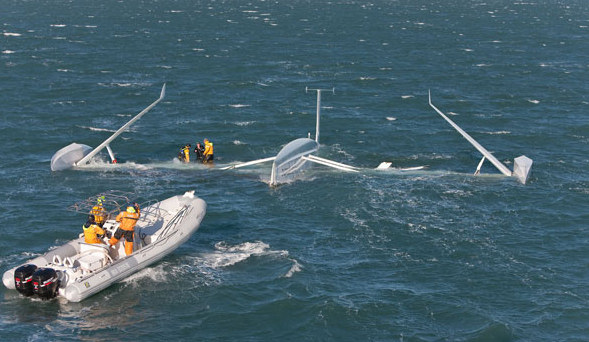
l’Hydroptere – The Record and The Wreck
©2008 Latitude 38 Media, LLC
Moments before it capsized on Saturday, the 60-ft French foiler l’Hydroptere hit 61 knots. That’s a tic over 70 mph, the legal speed limit on some California highways. It’s doubtful the brief burst will be ratified by the WSSRC, since to qualify as official, a speed must be maintained over 500 meters. But for Alain Thébault and his team of believers, the evening of December 20 was one of vindication and celebration. There was time enough on Sunday to tow the boat home and start feeling their cuts and bruises.
Thébault and famed French sailor Eric Tabarly conceived the idea for l’Hydroptere (‘the hydrofoil’) way back in 1975. The complex, 5-ton boat — which in winds above 12 knots rises onto port and starboard foils forward and a combination rudder/’elevator’ in back — was launched in 1994. Since nobody had ever built anything like her before, the learning curve consisted of sailing the boat, seeing what worked or broke, and then fixing any problems before the next outing. And lots of stuff broke. Thébault has suffered, nursed and repaired the boat through many breakdowns over the years.
Prior to the latest one, the ‘flying boat’ had a good couple of months. In early November, Thébault sailed to two new records off the team’s homeport and proving ground, Port Saint Louis du Rhone, which is on the Mediterranean coast of France near Marseilles. The first was 43.09 knots over a measured mile, which beat their own previous record. The second was 46.52 knots over 500 meters, which finally dethroned a 1993 record set by the Australian podsailor Yellow Pages Endeavor as the fastest sailboat on the planet. In early December, Thébault and his team made several personal appearances at the Paris Boat Show which drew enthusiastic crowds. Then it was back to the waters off Napolean Beach for the big push: break not only the top speed of any water craft under sail — currently 49.84 knots set by a kitesailor in September — but also break through sailing’s sound barrier, the almost mythical 50-knot mark.

On Saturday, Thébault and his nine-man crew did just that. With winds in the 35- to 38-knot range and a smallish swell, l’Hydroptere was flying along in the high 40s when she encountered a 45-knot gust. Boat speed climbed to 50 knots, then 55, 60, and finally, 61. Shortly thereafter, the boat pitchpoled, tossing the crew into the water and coming to rest upside down. The cause of the capsize was the very gust that permitted the extraordinary speed burst. “The gust was very violent,” said Thébault. “l’Hydroptere was in full acceleration at over 61 knots when she stopped and capsized.” As the crew were pulled out of the water by chase boats — a routine many of them are doubtless used to — there were the usual cuts and bruises. But there were also big smiles and high-fives and hugs. Official or not, they had finally done it. See more on l’Hydroptere at www.hydroptere.com/_en/
